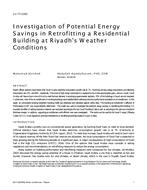Description
Recent official statistics have shown that Saudi Arabia electricity consumption growth rate at 7%. Buildings primary energy consumption and electricityconsumption are 23% and 80%, respectively. This trend of high energy consumption is expected to rise in the upcoming few years, and as a result, SaudiArabia will have to burn more of its oil to meet the local demand. According to governmental statistics, 70% of the buildings in Saudi are not insulated.Furthermore, most of the air-conditioners in existing buildings were installed before enforcing minimum performance standards on air-conditioners. In thispaper, an uninsulated existing residential building model was developed and validated against utility data. The building air-conditioner Coefficient ofPerformance (COP) was experimentally determined. The model was used to investigate the potential energy savings in retrofitting the building. Forexample, the effect of adding insulation material was evaluated according to the new Saudi Building Code as well as according to the optimum insulationthickness concept. In addition, upgrading air-conditioners with efficient ones were investigated. The results can be used by the Saudi Energy EfficiencyCenter (SEEC) to set regulations and recommendations on retrofitting buildings located in Saudi Arabia.
Citation: 2017 Winter Conference, Las Vegas, NV, Conference Papers
Product Details
- Published:
- 2017
- Number of Pages:
- 8
- Units of Measure:
- Dual
- File Size:
- 1 file , 630 KB
- Product Code(s):
- D-LV-17-C053




